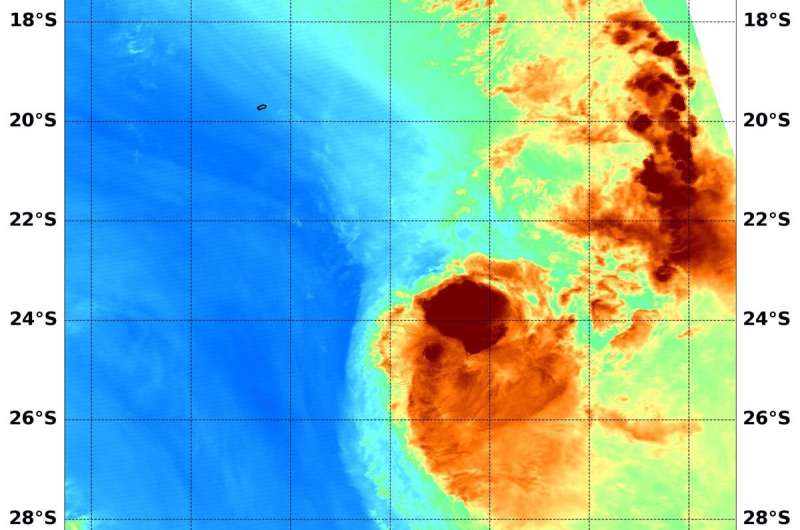NASA analyzes tropical cyclone Herold's water vapor concentration

When NASA's Aqua satellite passed over the Southern Indian Ocean on Mar. 18, it gathered water vapor data that showed wind shear was adversely affecting Tropical Cyclone Herold.
In general, wind shear is a measure of how the speed and direction of winds change with altitude. Tropical cyclones are like rotating cylinders of winds. Each level needs to be stacked on top each other vertically in order for the storm to maintain strength or intensify. Wind shear occurs when winds at different levels of the atmosphere push against the rotating cylinder of winds, weakening the rotation by pushing it apart at different levels. Strong wind shear from the northwest is battering Herold and pushing the strongest storms away from the center of circulation. Northwesterly winds affecting the storm are estimated between 25 and 30 knots (29 to 35 mph /46 to 56 kph)
What Water Vapor Reveals
NASA's Aqua satellite passed over Tropical Cyclone Herold on Mar. 18 at 5:40 a.m. EDT (0940 UTC) and the Moderate Resolution Imaging Spectroradiometer or MODIS instrument gathered water vapor content and temperature information. The MODIS data showed highest concentrations of water vapor and coldest cloud top temperatures were pushed about 48 nautical miles southeast of the center of circulation.
MODIS data showed coldest cloud top temperatures were as cold as or colder than minus 70 degrees Fahrenheit (minus 56.6 degrees Celsius) in those storms. Storms with cloud top temperatures that cold have the capability to produce heavy rainfall.
Water vapor analysis of tropical cyclones tells forecasters how much potential a storm has to develop. Water vapor releases latent heat as it condenses into liquid. That liquid becomes the clouds and thunderstorms that make up a tropical cyclone. Temperature is important when trying to understand how strong storms can be. The higher the cloud tops, the colder and the stronger the storms.
Herold's Status
On Wednesday, March 18, 2020 at 5 a.m. EDT (0900 UTC), the Joint Typhoon Warning Center or JTWC noted that Herold's maximum sustained winds had dropped significantly since the previous 24 hours and the storm weakened from hurricane-force to tropical storm force. Maximum sustained winds were near 55 knots. Herold was centered near latitude 22.7 degrees south and longitude 66.1 degrees east, about 516 nautical miles east-southeast of Port Louis, Mauritius. Herold was moving to the southeast.
JTWC forecasters expect Herold to continue moving southeast and further away from land areas while continuing to weaken. Forecasters noted that the storm is becoming subtropical but could dissipate within a day or two before it completes that transition.
What is a Sub-tropical Storm?
According to the National Oceanic and Atmospheric Administration, a sub-tropical storm is a low-pressure system that is not associated with a frontal system and has characteristics of both tropical and extratropical cyclones. Like tropical cyclones, they are non-frontal that originate over tropical or subtropical waters, and have a closed surface wind circulation about a well-defined center.
Unlike tropical cyclones, subtropical cyclones derive a significant proportion of their energy from baroclinic sources (atmospheric pressure), and are generally cold-core in the upper troposphere, often being associated with an upper-level low-pressure area or an elongated area or trough of low pressure.
NASA's Aqua satellite is one in a fleet of NASA satellites that provide data for hurricane research.
Tropical cyclones/hurricanes are the most powerful weather events on Earth. NASA's expertise in space and scientific exploration contributes to essential services provided to the American people by other federal agencies, such as hurricane weather forecasting.
Provided by NASA's Goddard Space Flight Center

















